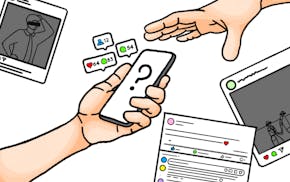Opinion editor's note: Editorials represent the opinions of the Star Tribune Editorial Board, which operates independently from the newsroom.
•••
The blackout license plate, which sold over 50,000 times within the first three months after its debut in January, is now the most purchased Minnesota specialty plate. Despite its popularity, it's not without its share of haters. Some things are just a matter of taste.
The blackout plates can look ominous, part of the intimidating aesthetics of huge, lifted pickups or sports cars with tinted windows. It also can be said that, from a quick glance or from afar, they resemble "whiskey plates" — those required to be displayed by DWI offenders under certain circumstances.
Another common grievance: They're boring.
Furthermore, some members of the Star Tribune Editorial Board, among whom opinions on this matter also vary, just don't love the idea of copying Iowa, where the blackout plate has been available since 2019 and is now more popular than the standard-issue plate. Other members of the board prefer the greater artistic merits of the various Critical Habitat plates offered in Minnesota, the proceeds of which are donated to the Department of Natural Resources (DNR).
This dislike of the blackout plates can also be chalked up, in a way, to "if it's not broke, don't fix it." The classic "10,000 lakes" plate, which has been in circulation since 1978, does a superstar job of embodying the spirit of Minnesota. The lakes, the blue-green color scheme, the canoe — designers nailed it. It's timeless and among the best of what can be hideous standard-issue plates across the United States. (Check out Maryland's and you'll feel better about whatever is going on up here in the North Country).
Even if the Minnesota standard plate were considered the Mona Lisa of plates (which would go too far, since the light color scheme sometimes makes them difficult to read), that doesn't mean a bit of change and variety is a bad thing. The simple blackout plate is also hardly a radical concept. It was a typical style across the country when the very idea of license plates was new.
Is it a little ugly? Perhaps with certain styles and colors of cars. But the simple, nostalgic look complements vintage cars far better than does the classic blue-green plate. And if you have a flashier-colored car, having the option for a more simple plate may be a stylistic godsend.
Blackout plates are also a significant source of additional state revenue that people are clearly willing to shell out for. Fifty thousand plates installed and counting, times the $30 annual fee for the plate, plus the initial $15.50 fee, means a good bit of extra cash for Driver and Vehicle Services (DVS). These proceeds go toward operations of DVS, which isn't nearly as romantic as saving the loons or the bees, but one would assume the department is using the extra funds for something worthwhile.
If the most damage the blackout plates can bring about is to cast a blight on the eyes of a few, Minnesota could do a lot worse. As long as people want to pay for them, the state may as well make more.
Editorial Board members are David Banks, Jill Burcum, Denise Johnson and John Rash. Star Tribune Opinion staff members Maggie Kelly, Kavita Kumar and Elena Neuzil and intern Aurora Weirens also contribute, and Star Tribune CEO and Publisher Steve Grove serves as an adviser to the board.

Rash: At home, Jake Sullivan reflects on events abroad

Opinion: Let's not lose sight of what's best for older adults

Readers Write: Minneapolis politics, Trump's budget, hot tub rentals
